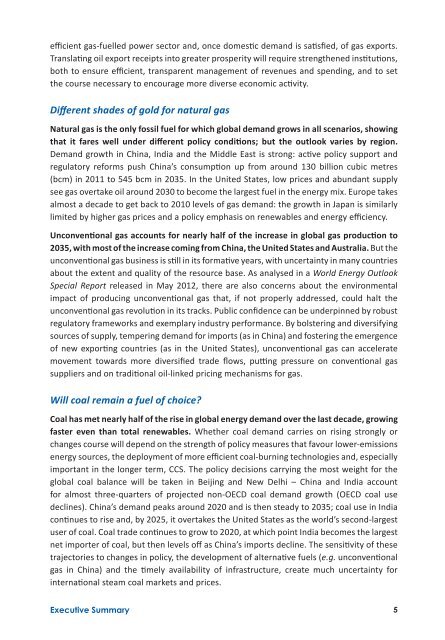World Energy Outlook 2012 – Executive Summary - IEA
World Energy Outlook 2012 – Executive Summary - IEA
World Energy Outlook 2012 – Executive Summary - IEA
Create successful ePaper yourself
Turn your PDF publications into a flip-book with our unique Google optimized e-Paper software.
efficient gas-fuelled power sector and, once domestic demand is satisfied, of gas exports.<br />
Translating oil export receipts into greater prosperity will require strengthened institutions,<br />
both to ensure efficient, transparent management of revenues and spending, and to set<br />
the course necessary to encourage more diverse economic activity.<br />
Different shades of gold for natural gas<br />
Natural gas is the only fossil fuel for which global demand grows in all scenarios, showing<br />
that it fares well under different policy conditions; but the outlook varies by region.<br />
Demand growth in China, India and the Middle East is strong: active policy support and<br />
regulatory reforms push China’s consumption up from around 130 billion cubic metres<br />
(bcm) in 2011 to 545 bcm in 2035. In the United States, low prices and abundant supply<br />
see gas overtake oil around 2030 to become the largest fuel in the energy mix. Europe takes<br />
almost a decade to get back to 2010 levels of gas demand: the growth in Japan is similarly<br />
limited by higher gas prices and a policy emphasis on renewables and energy efficiency.<br />
Unconventional gas accounts for nearly half of the increase in global gas production to<br />
2035, with most of the increase coming from China, the United States and Australia. But the<br />
unconventional gas business is still in its formative years, with uncertainty in many countries<br />
about the extent and quality of the resource base. As analysed in a <strong>World</strong> <strong>Energy</strong> <strong>Outlook</strong><br />
Special Report released in May <strong>2012</strong>, there are also concerns about the environmental<br />
impact of producing unconventional gas that, if not properly addressed, could halt the<br />
unconventional gas revolution in its tracks. Public confidence can be underpinned by robust<br />
regulatory frameworks and exemplary industry performance. By bolstering and diversifying<br />
sources of supply, tempering demand for imports (as in China) and fostering the emergence<br />
of new exporting countries (as in the United States), unconventional gas can accelerate<br />
movement towards more diversified trade flows, putting pressure on conventional gas<br />
suppliers and on traditional oil-linked pricing mechanisms for gas.<br />
Will coal remain a fuel of choice?<br />
Coal has met nearly half of the rise in global energy demand over the last decade, growing<br />
faster even than total renewables. Whether coal demand carries on rising strongly or<br />
changes course will depend on the strength of policy measures that favour lower-emissions<br />
energy sources, the deployment of more efficient coal-burning technologies and, especially<br />
important in the longer term, CCS. The policy decisions carrying the most weight for the<br />
global coal balance will be taken in Beijing and New Delhi <strong>–</strong> China and India account<br />
for almost three-quarters of projected non-OECD coal demand growth (OECD coal use<br />
declines). China’s demand peaks around 2020 and is then steady to 2035; coal use in India<br />
continues to rise and, by 2025, it overtakes the United States as the world’s second-largest<br />
user of coal. Coal trade continues to grow to 2020, at which point India becomes the largest<br />
net importer of coal, but then levels off as China’s imports decline. The sensitivity of these<br />
trajectories to changes in policy, the development of alternative fuels (e.g. unconventional<br />
gas in China) and the timely availability of infrastructure, create much uncertainty for<br />
international steam coal markets and prices.<br />
<strong>Executive</strong> <strong>Summary</strong> 5<br />
1<br />
2<br />
3<br />
4<br />
5<br />
6<br />
7<br />
8<br />
9<br />
10<br />
11<br />
12<br />
13<br />
14<br />
15<br />
16<br />
17<br />
18

















